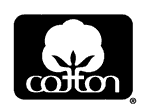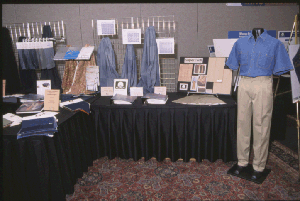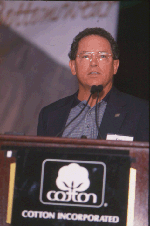
Cotton is “the fabric of our lives,” or at least so the folks at Cotton Incorporated, New
York City, would have us believe in their highly successful integrated marketing campaign a
communications blitz that permeates virtually every sector of American popular culture and has made
the Seal of Cotton among the most recognizable logos in the world.The Seal of Cotton, according to
the companys trade magazine ad (one that frequents these very pages) is more recognizable than
several other American icons, including Microsoft, Kodak, Prudential and Delta Air Lines.So the
question is: how does Cotton Incorporated engineer the positioning of natural products against the
new “cool” and trendy synthetic fibers and yarns that seemingly crop up on a daily basisATI found
some answers to this question during a visit to Cotton Incorporateds recent Denim and Casual
Bottomswear Conference at Pinehurst, N.C.The conference focused on product development, innovation
and marketing. Experts from throughout the textile, apparel, retail and marketing channels gave
presentations about the future of cotton yarns, fabrics and apparel.Innovation, responsiveness to
customer needs, speed to market, verticalization, strategic alliances and aggressive marketing are
the keys to success for companies that manufacture and sell in this market, the presenters agreed.
The market itself is very hot at the moment. Cotton crops are strong, employment in cotton-related
jobs is increasing substantially across all sectors, and retail sales are up 10.7 percent.”The
cotton market is very strong,” said Bob McCormack, president of GaleyandLord, Greensboro, N.C.
“Because of delivery issues, the numbers are even better than the retail numbers indicate.”Reasons
for the cotton boom, McCormack said, include the trend toward more companies implementing casual
days either full- or part-time, which has resulted in a marked increase in demand for dress and
casual cotton pants. Denim, as well, is enjoying resurgence because of a return to more basic denim
styles by younger consumers.The Caribbean Basin Initiative (CBI) offers some opportunity for
increased sales, McCormack said, but the World Trade Organization (WTO) presents a number of
challenges.”We wont be able to compete on price alone with the Far East,” he said. Availability of
labor and government subsidies will preclude American companies from selling on price. In addition,
he said, duties will still be in place.”I see the American textile industry becoming more flexible.
The U.S. must focus on product development and maintaining the best quality in the world. We must
be faster in development and faster in getting our products to market. We must see service
improvement.” McCormack said. American companies must be capable of rapidly fulfilling orders and
be able to quickly adapt to the demands of the marketplace, he added.Opportunities before the U.S.
textile industry include: the continued consolidation of textile companies to maximize strength and
resources; concentration on the higher-end products at which U.S. manufacturers excel;
verticalization into garment manufacturing or strategic alliances with apparel manufacturers;
increased service and more timely fulfillment; management of vendors in order to keep shelves
stocked; and the realization of export opportunities.From the apparel standpoint, aggressive
inventory management, flexibility and delivery are key, according to William W. Compton, chairman
and CEO, Tropical Sportswear International, Tampa, Fla.”We need to keep a consistent flow of water
through the hose,” he said. The goal of Tropical Sportswear is 30 days from source goods to
shipping.Tropical strives to carry no more than five days of raw materials to ensure flexibility
and customer responsiveness. As well, the company carries no more than 10 days work in process at
any facility.Quality remains, of course, a major issue, said Peter M. McGrath, vice president and
director, quality and sourcing, JCPenney, Plano, Texas. “Quality is the price of admission now,” he
said. “It is not an added value; it is an expectation.”

In product development, consumers are looking for fashionable, comfortable garments that are
complementary to their lifestyles and careers, according to Cindy Bellamy, vice president,
technical services, Avondale Mills Graniteville Fabrics Division, Graniteville, S.C. Mills and
apparel manufacturers need to concentrate on adding value to products as well as new technology,
environmentally-friendly product development and rapid customer response, she said. “And products
must be affordable,” she added.Throughout the conference, one theme came to the forefront from
presenter to presenter: the need for U.S. manufacturers to remain innovative in product
development. Perhaps nowhere is there more evidence of how successful innovation can be than in the
casual market.”The casual market is an American icon,” said Joe Don Long, fabric finish developer,
Dockers Product Development, Levi StraussandCo., San Francisco. “It is as American as cowboys and
jeans.”Long took his audience through a typical Dockers product launch, from concept through
product introduction. In the line-build stage, when the product is in concept, factors to consider
include business objectives, design initiatives and product opportunities. At line launch, the
transition begins from development to production.At this stage, sales samples are produced and
evaluated. Next come pre-production runs, in which a small amount of product is processed to
identify areas of concern and make final modifications. At the first of production stage, mass
production begins. Any glitches are reviewed and corrected before product gets in the
channel.Fitting the product to the customer is essential, Long said. He generated a ripple of
laughter in the audience when he likened product development to the building of Noahs Ark.”We know
God had something specific in mind when he told Noah to build the Ark,” he said, showing a drawing
of the Ark as it often appears in religious literature.”But, is that what Noah had in mind” he
asked, showing a slide of a sleek sailboat in sunny tropical waters. “Nice, but obviously not
equipped for the task,” he continued. “Now, Im not trying to say that designers and product
developers are gods,” he quipped. “But, then, Im not saying they arent.”Beyond innovation, speed to
market, alliances and such, the other key factor is aggressive marketing. Creative, targeted
marketing strategies do not guarantee success for any endeavor. They do, however, create the
opportunity for success if product, price, distribution, service, etc., are competitive. Marketing
is, as well, an arena in which many companies could stand to be a bit more aggressive including any
number of U.S. textile manufacturers.The powers that be at Cotton Incorporated, as evidenced by the
presentations at the conference, understand the fundamental maxim of marketing: all things being
equal, brand name always carries the day. As proof, Cotton Incorporated points to research that
shows merchandise carrying the Seal of Cotton sells 27 percent more than merchandise without it.
Cotton Incorporated innundates America with its advertising and promotional messages. The
organization is on television, in magazines both consumer and trade, on billboards, and in the
malls especially in the malls.Cotton Incorporated is well aware of who is in a position to make
purchasing decisions. Spurred by the popularity of “Casual Fridays,” sales of denim and casual
bottomswear have steadily increased over the past few years. So it makes perfect sense for Cotton
Incorporated to target the young professional in its advertising campaign. But the company also
pays considerable attention to Generation Y, the hip youngsters who determine the very definition
of cool.This same generation is often seen as the scourge of the mall. Youngsters walk by, run by,
even much to the consternation of some security folks skateboard by. They tend to disrupt the
activities of the slightly older Generation-X shoppers and bring downright outrage to aging Baby
Boomers.But as these young people go by, they also go buy. And Cotton Incorporated knows this. So
when Glendale, Calif.s Galleria Center decided to undertake an innovative and risky concept to
accommodate this younger generation, Cotton Incorporated was among the first on-board.The Zone at
Glendales Galleria is a new specialty retail and entertainment destination created within the mall
to specifically address the lifestyle preferences of Generation-Y consumers. In addition to a
collection of Generation Y-targeted shops, The Zone also features, among other things, its very own
internal television station Channel Z TV and the popular “Cotton Cam.” Cotton Cam, sponsored, of
course, by Cotton Incorporated, invites Generation-Y visitors to show their cotton fashions and
stylish, graceful moves. Images from Cotton Cam are broadcast live throughout The Zone, and those
with the coolest apparel and graceful moves have the opportunity to win prizes.”The Zone concept
has been a tremendous success,” Annette Bethers, senior marketing director for Glendale Galleria,
told attendees at the bottomswear conference. What many regard as a liability of mall shopping
loitering teens has been turned into a considerable asset with substantial purchasing power.Cotton
Incorporated also has an advertising presence on The WB Network, which is now the number one
television network among Generation-Y viewers, according to Jamie Kellner, WB Networks chief
executive officer. The Seal of Cotton has become a visible symbol of a new age of consumers who
refuse to sacrifice either fashion or comfort. Cotton Incorporateds aggressive marketing tactics,
coupled with its continuing driving for innovation, have obviously played a major role in the
increasing demand for natural fabrics. Functional Finishes Enhance Cotton Fabrics By Improving
PerformanceInnovation and enhancement are two of the hot catchwords in the market today, according
to Donald L. Bailey, vice president, textile research and implementation, Cotton
Incorporated.Bailey, speaking at Cotton Incorporateds annual Denim and Casual Bottomswear
Conference, said the consumer wants innovation, and the industry is trying to respond.”Innovation
is also known by other names,” he said. “These include high-tech, intelligent textiles,
nano-technology and others. At Cotton Incorporated, our efforts to achieve innovation center on the
concept of enhancement by functional finishing.”Cotton Incorporateds efforts in providing multiple
finishes to cotton products result in a steady stream of new and innovative products to the
industry. “In functional finishes, the most important new concepts are soil release and repellency,
water repellency, moisture management, antimicrobial properties, stain resistance, UV protection
and other concepts such as scented fabrics,” Bailey said.Fabrics and garments can be enhanced by
many methods, he added. These can be physical, chemical or a combination. Although enhancement has
traditionally been performed in the textile arena, more and more products are being developed for
use by the consumer in home laundering appliances.Hydroenhancement of fabrics is based upon the use
of hydro-entanglement equipment commonly used to form nonwoven substrates, Bailey said. The system
uses micro-jets of high-energy water to impact yarns, causing them to bloom and entangle with
adjacent yarns in a fabric, layered fabrics or fiber webs.When the micro-jets of water strike the
fibers in the yarns and cause them to be further entangled, the result is improved bulk and cover,
improved abrasion resistance, reduced pilling, reduced seam slippage, increased yield, lower
shrinkage, reduced color (if desired), cleaner substrates, physical patterning and, when two or
more layers are enhanced together, lamination. An overall patterning effect can be achieved, he
said.Hydroentanglement of denim, for example, can produce a number of desirable results, he added,
such as uniform color loss as a result of fabric-width coverage by the micro-jets. A pin striping
can be achieved using only a fine, localized stream of jets. By using a patterned screen on the
backside of the fabric, patterns and surface effects can be achieved.Needle enhancement makes use
of the traditional needle-punching equipment utilized extensively in the nonwovens industry, Bailey
said. Multiple strokes of specially designed needles penetrate the fabric and entangle fibers
within the structure. Many fibers are pushed though to the side opposite the needles penetration.
The results can vary from entanglement of a single fabric to lamination of fabric and fiber
webs.Home product-care enhancements give the consumer a voice in how garments look after repeated
launderings, he said. “For some time now, detergents have included enzymes to remove the hairiness
from laundered cotton products,” Bailey explained. “The result has been a smoother surface and
better color definition. Today the consumer can choose among products that contain liquid fiber,
which is used in the washer to lubricate or protect cotton fabric from becoming scuffed and
worn.”In addition, dry cleaning systems are offered for home use to eliminate stains, spots and
odors from “dry-clean only” fabrics. “Soon to be offered,” he said, “are detergent substitutes for
indigo and black denims to reduce color loss during laundering.” These products have shown
remarkable color retention improvements in garments that have gone through more than 30 laundering
cycles. Cotton Incorporated is also developing a home wrinkle-resistant finishing system for cotton
garments to enable the consumer to improve the smooth-drying charac-teristics of those garments.”In
conclusion, these innovations are just the tip of the iceberg of new and improved concepts that
must come forward in the future,” Bailey said. “As researchers, we must constantly think outside
the box to create new products.”

Cotton Incorporated’s Donald L. Bailey
October 2000







